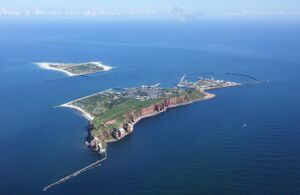Organization:Heligoland Bird Observatory
The Heligoland Bird Observatory (Vogelwarte Helgoland in German), one of the world's first ornithological observatories, is operated by the Ornithologische Arbeitsgemeinschaft Helgoland e.V., a non-profit organization which was founded in 1891 to support research on the fauna of Heligoland, a small Germany archipelago, comprising the islands of Heligoland and Düne, in the Heligoland Bight of the North Sea. The principal research focus is on bird migration through banding studies. Over 400 species have been recorded. OAG Helgoland produces an annual bird report.
History
Heligoland is on a major migration route for birds crossing the North Sea; for centuries, both those on migration and those breeding there, were an important source of food for the islanders. In the early 19th century Heligoland also became a source of bird specimens for collectors and museums. Ornithologist and artist Heinrich Gätke first visited the island in 1837 and moved there permanently in 1841 as secretary to the British Governor. He began collecting specimens of rarities for both artistic and scientific purposes. He spent most of the next 60 years studying the birds and coined the term "Vogelwarte", producing a book ("Die Vogelwarte Helgoland") on his research in 1891, with an English translation published in 1895. The modern observatory was established in 1910 by Hugo Weigold with a systematic trapping and banding program using the "Heligoland traps" he developed.[1]
References
Notes
- ↑ Hünemörder (1995).
Sources
- Hünemörder, Ch. (1995). "Ornithology on the island of Helgoland and the role of the Biologische Anstalt up to the foundation of the separate "Vogelwarte"". Helgoland Marine Research 49 (1–4): 125–134. doi:10.1007/BF02368343. Bibcode: 1995HM.....49..125H.
- "OAG Helgoland". Ornithologischen Arbeitsgemeinschaft Helgoland e.V.. http://www.oag-helgoland.de/en/.
- "RRBO: History". Raccoon Ridge Bird Observatory. http://www.raccoonridgebirdobservatory.com/history.htm.
Further reading
- Gätke, Heinrich (1895). Heligoland as an ornithological observatory; the result of fifty years' experience. Edinburgh: D. Douglas. https://archive.org/details/heligolandasorni00gtrich.
[ ⚑ ] 54°11′N 7°53′E / 54.183°N 7.883°E
 |




